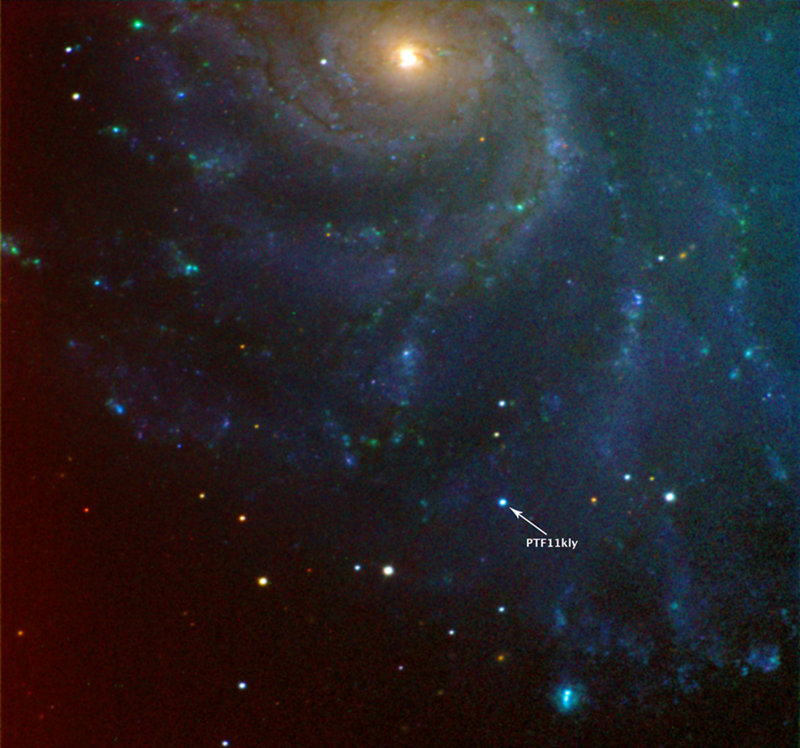Twenty-one million years ago in the Pinwheel Galaxy — an elegant, spiral-armed neighbor of our own Milky Way — an old, dim star had a very bad day. It exploded and began to blaze like a billion suns.
On Aug. 24, Peter Nugent had a very good day. The Lawrence Berkeley National Laboratory astrophysicist was about to grab lunch when he checked to see if a robotic telescope had spied anything of interest the night before. Bingo. Boom. Supernova.
And not just any supernova. Every night, astronomers spot several exploding stars across the universe. But this one was so close — in cosmic terms — and seen so soon after its light reached Earth that astronomers are calling it the supernova of a generation.
An automated sky survey that searches for new nighttime objects with a telescope at California’s storied Palomar Observatory first flagged the supernova.
Soon, telescopes around the world — and beyond, including the Hubble Space Telescope — swiveled to take a peek.
“This is a special event,” said Ken Sembach of the Space Telescope Science Institute in Baltimore. “Everyone wants a piece of it.”
Nugent said the blaze will continue to brighten until Wednesday or Thursday, visible just above the handle of the Big Dipper to backyard astronomers with binoculars.
The last supernova to generate such buzz flared into view in 1972. Before that, a 1937 explosion caught everyone’s attention.
“This is not an every-year event,” said Robert Kirshner, a veteran Harvard University supernova hunter. “This is an every-decade-or-four event.”
Three hours after Nugent’s discovery, the Grand Canary Telescope off the coast of Africa — where the sun had just set — took a look. The jackpot grew bigger when that scope’s data poured in. The Pinwheel supernova — technically known as SN2011FE — was a Type 1a, of special interest to astronomers.
Type 1a’s all blaze with nearly the same brightness. That makes them the perfect yardsticks for measuring cosmic distances. Their apparent brightness tells us how far away they are.
In the 1990s, Kirshner led a team that leveraged this property to make one of the biggest discoveries of the past century: The universe is flying apart, rapidly accelerating.
To explain this, cosmologists were forced into an uncomfortable conclusion. Either gravity does not work the way it is supposed to, or a mysterious force is pushing galaxies apart at a quickening pace. They called this unknown force “dark energy” and still have little idea what it is, even though they are able to calculate that it constitutes an astounding 73 percent of all mass and energy in the universe.
Cosmologists hope the new supernova will help refine estimates of the universe’s acceleration. The data might even hint at the nature of dark energy.
Professional stargazers also point to the Pinwheel supernova as the best candidate to fill another gap in their knowledge: the precise sequence of events that causes such explosions. They are fairly certain Type 1a’s start with old, dim stars called white dwarfs. Such stellar husks have blown away their outer layers after running out of fuel. This fate awaits our own sun in about 5 billion years.
For our sun, that will be the end. But some white dwarfs reincarnate as their high gravity sucks material from nearby companion stars. The dwarf reaches a critical mass, about 1.4 times that of our sun. A runaway explosion ensues.
That’s one possibility. In another, two white dwarfs might circle each other until they collide and explode.
“This is where the mystery lies,” said Roseanne Di Stefano, a Harvard University astrophysicist. “There’s still a lot of uncertainty in the field as to whether one or both happen.”
Copy the Story Link
Send questions/comments to the editors.



Success. Please wait for the page to reload. If the page does not reload within 5 seconds, please refresh the page.
Enter your email and password to access comments.
Hi, to comment on stories you must . This profile is in addition to your subscription and website login.
Already have a commenting profile? .
Invalid username/password.
Please check your email to confirm and complete your registration.
Only subscribers are eligible to post comments. Please subscribe or login first for digital access. Here’s why.
Use the form below to reset your password. When you've submitted your account email, we will send an email with a reset code.